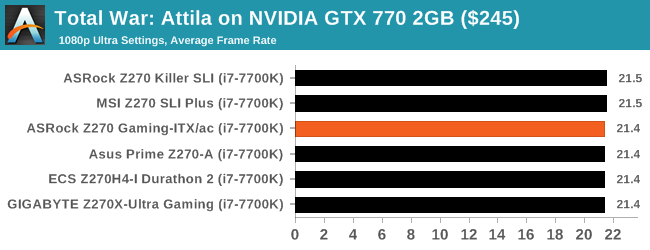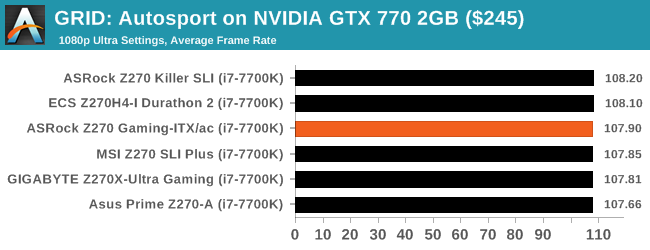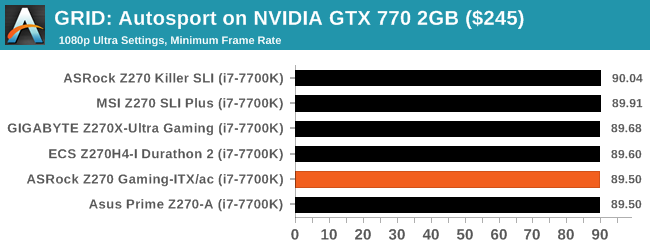The ASRock Fatal1ty Z270 Gaming-ITX/ac Motherboard Review
by E. Fylladitakis on September 19, 2017 9:00 AM EST- Posted in
- Motherboards
- Intel
- ASRock
- Mini ITX
- Z270
- 7700K
- Z270 Gaming ITX/ac
The ASRock Z270 Gaming-ITX/ac Review
Gaming Performance
The issue of FCLK settings might play a big role here. At launch, the default setting for the communication buffer between the CPU and PCIe stack was 800 MHz, even though Intel suggested 1000 MHz, but this was because of firmware limitations from Intel. Since then, there is firmware to enable 1000 MHz, and most motherboard manufacturers have this - but it is unclear if the motherboard will default to 1000 MHz and it might vary from BIOS version to BIOS version. As we test at default settings, our numbers are only ever snapshots in time, but it leads to some interesting differences in discrete GPU performance.
Total War: Attila
The Total War franchise moves on to Attila, another The Creative Assembly development, and is a stand-alone strategy title set in 395AD where the main storyline lets the gamer take control of the leader of the Huns in order to conquer parts of the world. Graphically the game can render hundreds/thousands of units on screen at once, all with their individual actions and can put some of the big cards to task.
For low-end graphics, we test at 720p with performance settings, recording the average frame rate. With mid and high range graphics, we test at 1080p with the quality setting. In both circumstances, unlimited video memory is enabled and the in-game scripted benchmark is used.

GRID: Autosport
No graphics tests are complete without some input from Codemasters and the EGO engine, which means for this round of testing we point towards GRID: Autosport, the next iteration in the GRID and racing genre. As with our previous racing testing, each update to the engine aims to add in effects, reflections, detail, and realism, with Codemasters making ‘authenticity’ a main focal point for this version.
GRID’s benchmark mode is very flexible and, as a result, we created a test race using a shortened version of the Red Bull Ring with twelve cars doing two laps. The car is focus starts last and is quite fast, but usually finishes second or third. For low-end graphics, we test at 1080p medium settings, whereas mid and high-end graphics get the full 1080p maximum. Both the average and minimum frame rates are recorded.














41 Comments
View All Comments
GeorgeH - Tuesday, September 19, 2017 - link
100-1 something is overheating and the board is just fine.only1jv - Wednesday, September 20, 2017 - link
that's what i figured, so i tried a different GPU, same result. I even swapped the PSU, same result. Swapped the memory, same result.The only thing i haven't swapped is the CPU but i'm running the Corsair H100i AIO watercooler and have never seen temps on it go above 70c.
I figure it has to be the mobo itself because it would even lockup while in the BIOS.
Oh and yes, i already requested an RMA. Just wanted to share my experience with this mobo after seeing this review and how after a few months it's now failing on me.
Ej24 - Wednesday, September 20, 2017 - link
It was probably the VRM for delivering power to the cpu that was overheating causing the issue. There's no monitoring software for that so most people forget about it. Maybe you got some particularly hot chokes, mosfets, or caps that were just prone to overheating. At any rate, hope the RMA goes well.sonny73n - Thursday, September 21, 2017 - link
Last month I ran into the same problem but with Asus MB. Most of the time "clock_watchdog_timeout" error appeared when it froze. The weather then was about 100F in Southern Ca. CPU stock HSF replaced + case opened = problem solved.The_Assimilator - Wednesday, September 20, 2017 - link
Allow me to introduce you to this magical concept know as "RMA".lucam - Wednesday, September 20, 2017 - link
Still no iPad Pro review yet..:(Beaver M. - Wednesday, September 20, 2017 - link
I would really like to know why they removed 1 USB port at the IO panel.It was still there on the Z170 version.
Also putting in WiFi as part of the board, that cant be removed, is not a good idea either. They might have saved some space on the board, but they didnt use it (for example more USB headers), and instead wasted space on the IO panel. Some people just dont need WiFi and/or Bluetooth.
Also why doesnt AT test if the notorious ASRock USB problem with long or extended cables still exists, which could only be fixed by taking an non-Intel USB chip (either if one is on the board, or an extra PCIe card)? It has been known for at least 5 years...
DanNeely - Thursday, September 21, 2017 - link
They probably used a cheaper 1x USB3.1g2 controller. A year or two ago I don't think that budget version was available yet.bak0n - Thursday, September 21, 2017 - link
I find it odd that they release it now, when the 370's are right around to corner. A bit late to the game for my taste.mickulty - Thursday, September 21, 2017 - link
The 87350D mosfets (actually "power blocks" integrating high and low sides) are actually supplied by TI - NexFET is the range that they're from.